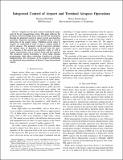Integrated Control of Airport and Terminal Airspace Operations
Author(s)
Khadilkar, Harshad; Balakrishnan, Hamsa
DownloadIntegrated Control of Airport.pdf (821.2Kb)
OPEN_ACCESS_POLICY
Open Access Policy
Creative Commons Attribution-Noncommercial-Share Alike
Terms of use
Metadata
Show full item recordAbstract
Airports are the most resource-constrained components of the air transportation system. This paper addresses the problems of increased flight delays and aircraft fuel consumption through the integrated control of airport arrival and departure operations. Departure operations are modeled using a network abstraction of the airport surface. Published arrival routes to airports are synthesized to form a realistic model of arrival airspace. The proposed control framework calculates the optimal times of departure of aircraft from the gates, as a function of the arrival and departure traffic as well as airport characteristics such as taxiway layout and gate capacity. The integrated control formulation is solved using dynamic programming, which allows calculation of policies for real-time implementation. The advantages of the proposed methodology are illustrated using simulations of Boston's Logan International Airport.
Date issued
2015-05Department
Massachusetts Institute of Technology. Department of Aeronautics and Astronautics; Massachusetts Institute of Technology. Institute for Data, Systems, and SocietyJournal
IEEE Transactions on Control Systems Technology
Publisher
Institute of Electrical and Electronics Engineers (IEEE)
Citation
Khadilkar, Harshad and Balakrishnan, Hamsa. “Integrated Control of Airport and Terminal Airspace Operations.” IEEE Transactions on Control Systems Technology 24, no. 1 (January 2016): 216–225. © 2016 Institute of Electrical and Electronics Engineers (IEEE)
Version: Author's final manuscript
ISSN
1063-6536
1558-0865